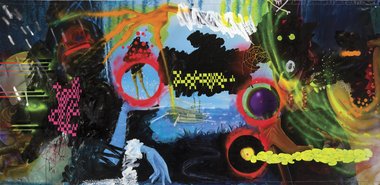Peter Dornauf – 21 August, 2012
There does appear to be a degree of ambiguity here in her strategy. Are the whorlings of paint, the crossings out, the obliteration and smudging of the original kitsch images an attempt at cancellation or mockery? If the latter, is she implying that her expressionist brushstrokes are as goofy and as emotionally over-laden as the photographic Sci Fi images themselves? Is she in other words, hamming both up?
Hamilton
Judy Darragh
SCI FI
Curated by Karl Chitham
August 20 - October 5, 2012
Judy Darragh is no stranger to the vulgar, the cheap and nasty, the gaudy and the ill-bred. It’s the meat and drink with which she has had a love hate relationship with for a long while now. In one sense it must be easy, given the plethora of material to work with, yet in another sense, it’s also difficult, in that one could easily end up repeating oneself given the focus is that narrow.
Her focus in her recent show, SCI FI, curated by Karl Chitham, on at the Calder and Lawson Gallery, presents a slight departure from her normal sculptural pieces. But it is still quintessential Darragh, employing lots of loudness, tons of bigness, brash, splash, dash and crash. This is art with the volume booming thud thud thud; art as melodrama.
The starting point are massive glossy PVC movie banners advertising B grade science fiction films which she purchased for a few dollars each. On top of these she has superimposed scribbles and dribbles of overlaid paint in garish colours, together with abstract squares cut from masking tape. These jostle for position and attention among the swooping jet planes and blazing laser firing guns in some futuristic setting.
This actually is not an absolutely new departure for Darragh who for the most part has dealt with sculptural forms of the kitsch variety. It is the same in this show, but here the flatness of image is something she’s visited earlier in works that featured pornographic pin-up girls. There she slobbered with white globules of paint over their near naked bodies in a blatantly sexualized manner.
Over the top is Darragh’s style, and typically in her latest work she hasn’t held back. The opposite of minimalism, the artist glories in the expressionist extravagance, all emotional brouhaha of paint application. This matches and plays off against the glamour of violence associated with the images she is dealing with here.
This is her trademark style which she has been working at for nearly thirty years, mining the tacky, the tawdry, the bad taste - the tea-towel end of the market.
These works grab the eye immediately, but one soon tires of the bluster involved, the overindulgence, the surfeit of strobes and splotches of pigment, the ack ack of paint with its whiplash and graffiti-like splodges and smears. Is Darragh really enjoying it or is she critiquing sardonically? Possibly both at the same time.
There does appear to be a degree of ambiguity here in her strategy. Are the whorlings of paint, the crossings out, the obliteration and smudging of the original kitsch images an attempt at cancellation or mockery? If the latter, is she implying that her expressionist brushstrokes are as goofy and as emotionally over-laden as the photographic Sci Fi images themselves? Is she in other words, hamming both up? Is there an art critique here as well as an attack on commercial infantilism?
Sex and violence are stable Hollywood fare, pandering to the lowest common denominator which these gratuitous images have in spades, but Darragh has a further trick at work here which she cleverly directs at the technical side of the medium itself. Her pixilated abstracts evoke the electronic system of communication involved in the transmission of filmic images which she runs across her ground in an ironic twist of revenge.
There’s also an element of the Pop art genre referenced here, in the taking of commercial images and playing with them, subverting them, but more violently than either Warhol or Lichtenstein ever did. Lichtenstein’s As I Opened Fire, for example, is an engagement with the formal qualities of the original war comic-book image, a celebration of it’s low-tech means, a paying homage, while Darragh is intent on destruction and annihilation, using a kind of bad painting grunge style to do it.
My only criticism of the show is the fact of the sameness that pervades all the pieces. You see one and you’ve seen them all. The show is accompanied by a substantial essay by the curator, packaged together with large sized colour images of the works.
Peter Dornauf
Recent Comments
Peter Dornauf
They are Pollock size. They look like a cross between Pop art and abstract expressionism, a real soup mix. The ...
John Hurrell
They look pretty gutsy, Peter. How big are those banners? The work seems like a synthesis of Don Driver collages ...






 Advertising in this column
Advertising in this column Two Rooms presents a program of residencies and projects
Two Rooms presents a program of residencies and projects



This Discussion has 2 comments.
Comment
John Hurrell, 9:07 a.m. 21 August, 2012 #
They look pretty gutsy, Peter. How big are those banners? The work seems like a synthesis of Don Driver collages with Ed Paschke paintings. Hollywood dross becomes engrossing with the added paint handling.
Peter Dornauf, 11:05 a.m. 21 August, 2012 #
They are Pollock size. They look like a cross between Pop art and abstract expressionism, a real soup mix. The biggest would be at least 4 yards long and 2 yards wide.
They initially have an impact but one soon gets bored. In reality she's aiming at an easy target.
Participate
Register to Participate.
Sign in
Sign in to an existing account.